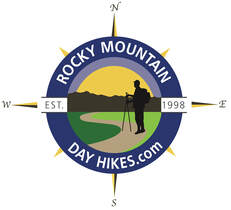|
Notes from the
Trail |
|
Nothing. I turned the key in the ignition again, and again, nothing. This trip to Timberline Falls in the Loch Vale was not off to a good start and I thought about bailing right then and there. But, after finally getting a jump from a friend, I was at the Glacier Gorge parking lot by noon. Just a little late. I started gathering my gear, pack, camera bag, poles, snowshoes. Huh? Where are the snowshoes? Huh! Did I really forget to load the snowshoes? Wow! I guess if I was looking for reason to bail, this would do it.  Well, I thought to myself sitting in the parking lot, the trail to Alberta Falls should be well packed from snowshoers. In fact, I would guess that most of the people on the trail at this time of year would be going well beyond the one mile to Alberta Falls and are snowshoeing to either Mills Lake or The Loch. And since we had not had any fresh snow in a while, there was a good chance I could get to one of the two lakes just hiking in my boots on packed snow. As late as the day was though, and without the snowshoes, Timberline Falls was not going to be in the cards today. Alright, I told myself, I’ll get on the trail and just see how things go. About an hour latter, I was at the trail junction for Mills Lake and The Loch. The day was warm and there wasn’t any fresh snow on the trees, and Alberta Falls was so filled in with snow it wasn’t even recognizable as a waterfall. As I walked along, I watched for interesting shadow patterns in the trees to photograph, but nothing had caught my attention. Standing at the junction, I debated which lake I should go to. I looked at the sun, low on the horizon, it would be setting behind the mountain ridges soon. 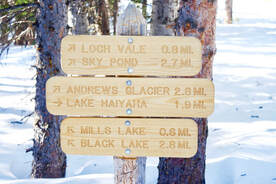 According to the trail sign, The Loch was 0.8 miles away, only 0.2 miles more than Mills Lake (though getting to the Loch always seemed to take much longer to me). But I decided to hike up to The Loch anyways, since that was on the way to my original destination. Not too far up the trail, I stop to quiz Steve and Walt who were coming down from The Loch. They also did not have snowshoes on. I asked how things went. Steve said they would have faired better with snowshoes. Walt said there was a spot where the trail just disappeared under the snow. I knew where that spot was, I had encountered that spot before when winter trekking to The Loch. In fact, this is one of the last places for the snow to melt off this trail in early summer. It’s a spot where the terrain begins to descend below the lake. The winter winds drop off the high peaks that surround The Loch, gathering considerable speed and snow, before shooting across the lake, sandpapering the ice and blasting any trees and persons in its path. The wind then launches straight out over the tops of the trees from the lake. But at this particular 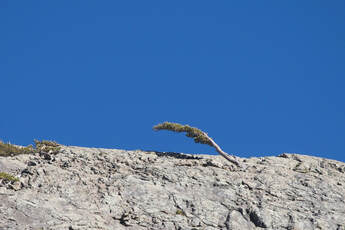 spot about 30-40 yards below the lake, some of the snow carried by the wind drops out and creates a sizable drift over the trail. It usually means losing all traces of the trail and knee deep wading for a little bit if you didn’t have snowshoes. I felt I could manage that. They also commented on how strong the wind gusts were while they sat for lunch at the lake. But Steve said it was absolutely gorgeous there. I knew that was true. I thanked them for the info and continued on, but only for a few moments. I decided it was not too late to change my mind and head for Mills Lake instead. At this point in the day, Mills Lake just seemed like a better destination. I don’t know if it’s true or not, but it always seems like the wind is stronger at The Loch. I speculated that it had something to do with The Loch’s east-west orientation whereas the ridges on either side of Mills Lake were oriented more north-south. A fine bit of pure speculation, I thought to myself, and soon I was crossing over the open rock slabs that lead to Mills Lake at just past 1:30. 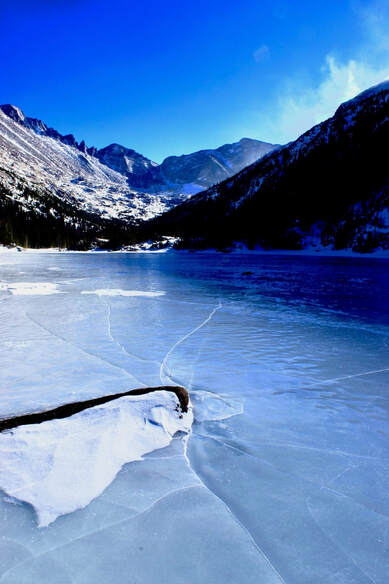 It was windy at the lake, but not horrendous. The wind had done a terrific job of clearing the snow off the entire ice covered lake and the ice was thick and polished smooth. I dropped my pack, pulled my camera out of the bag and started taking pictures. Though the sun was casting shadows off The Spearhead farther up, there was still sun on the icy lake. Snow filled the cracks in the ice, creating interesting patterns, and I ventured out onto the slick ice a little ways and dropped down to photograph the patterns. The wind caught me camera bag and scooted it back across the ice toward the shoreline. I moved around to different parts of the lake trying to bring the large boulders protruding from the ice into the foreground. At one point a jet raced through my photo, leaving a contrail stretching behind it like a taut piece of white yarn. Wrecking the photo I had just set up, I rolled over on the ice and groaned. The shadow from the west ridge was beginning to move across the lake now and I moved up the shoreline trying to stay in the sunlight. But once the shadow had drifted across the lake, I packed up and started to head back, happy I had made it before losing the sun at 2 o’clock. There were a couple of other people taking pictures and one commented to me that they liked the light with the shadow on the lake. I looked back and saw interesting light patterns. 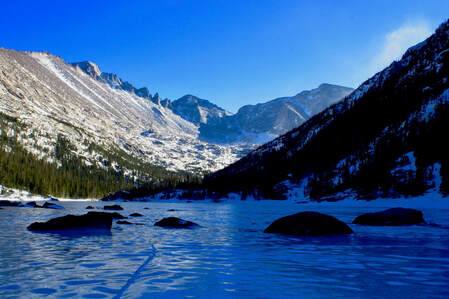 The surrounding peaks were still basking in the late day sun and they cast a reflection on the ice that was not seen until west ridge blocked the sun. The reflected lighting created little shadows on the dimples in the surface of the ice as if frozen lake ripples. To the right, the southern ridge line blocked the reflection leaving subtle shades of rippled blue. A very different and beautiful kind of image emerged with the shadow. Though the sun on the distant peaks drew the immediate attention of the eye, the real beauty was found in the shadow with its varied color and texture. Once again, as with much of this day, I reconsidered things, reached for my camera and tripod, and stayed a little longer at the lake. There were many opportunities to walk away today, and sometimes the situation is such that turning back makes the most sense. But often if we stay open, we can find a way forward, even if the outcome might be different than what we had originally envisioned.
0 Comments
Leave a Reply. |
"The wild requires that we learn the terrain, nod to all the plants and animals and birds, ford the streams and cross the ridges, and tell a good story when we get back home." ~ Gary Snyder
Categories
All
“Hiking -I don’t like either the word or the thing. People ought to saunter in the mountains - not hike! Do you know the origin of the word ‘saunter?’ It’s a beautiful word. Away back in the Middle Ages people used to go on pilgrimages to the Holy Land, and when people in the villages through which they passed asked where they were going, they would reply, A la sainte terre,’ ‘To the Holy Land.’ And so they became known as sainte-terre-ers or saunterers. Now these mountains are our Holy Land, and we ought to saunter through them reverently, not ‘hike’ through them.” ~ John Muir |
© Copyright 2025 Barefoot Publications, All Rights Reserved

